Restoring Coal Mining-Affected Areas: The Missing Ecosystem Services
Abstract
1. Introduction
2. Materials and Methods
2.1. The RECOVERY Project
2.2. The Study Area
2.3. Ecosystem Services Assessment
2.4. Economic Assessment
3. Results
4. Discussion
5. Conclusions
Author Contributions
Funding
Institutional Review Board Statement
Informed Consent Statement
Data Availability Statement
Conflicts of Interest
References
- Krzemień, A.; Álvarez Fernández, J.J.; Riesgo Fernández, P.; Fidalgo Valverde, G.; García-Cortés, S. Valuation of ecosystem services based on EU carbon allowances—Optimal recovery of a coal mining area. Int. J. Environ. Res. Public Health, 2022; revision. [Google Scholar]
- De Groot, R.S.; Wilson, M.A.; Boumans, R.M.J. A typology for the classification, description and valuation of ecosystem functions, goods and services. Ecol. Econ. 2002, 41, 393–408. [Google Scholar] [CrossRef]
- Raudsepp-Hearne, C.; Peterson, G.D.; Bennett, E.M. Ecosystem service bundles for analysing trade-offs in diverse landscapes. Proc. Natl. Acad. Sci. USA 2010, 107, 5242–5247. [Google Scholar] [CrossRef]
- De Groot, R.S.; Blignaut, J.; Van Der Ploeg, S.; Aronson, J.; Elmqvist, T.; Farley, J. Benefits of Investing in Ecosystem Restoration. Conserv. Biol. 2013, 27, 1286–1293. [Google Scholar] [CrossRef]
- Baró, F.; Gómez-Baggethun, E.; Haase, D. Ecosystem service bundles along the urban-rural gradient: Insights for landscape planning and management. Ecosyst. Serv. 2017, 24, 147–159. [Google Scholar] [CrossRef]
- Saarikoski, H.; Mustajoki, J. Valuation through deliberation—Citizens’ panels on peatland ecosystem services in Finland. Ecol. Econ. 2021, 183, 106955. [Google Scholar] [CrossRef]
- Hein, L.; van Koppen, K.; de Groot, R.S.; van Ierland, E.C. Spatial scales, stakeholders and the valuation of ecosystem services. Ecol. Econ. 2006, 57, 209–228. [Google Scholar] [CrossRef]
- The Economics of Ecosystems and Biodiversity (TEEB). The Economics of Ecosystems and Biodiversity Ecological and Economic Foundations; Kumar, P., Ed.; Earthscan: London, UK; Washington, DC, USA, 2010; Available online: https://www.teebweb.org/wp-content/uploads/Study%20and%20Reports/Reports/Ecological%20and%20Economic%20Foundations/TEEB%20Ecological%20and%20Economic%20Foundations%20report/TEEB%20Foundations.pdf (accessed on 27 August 2022).
- Saarikoski, H.; Mustajoki, J.; Barton, D.N.; Geneletti, D.; Langemeyer, J.; Gomez-Baggethun, E.; Marttunen, M.; Antunes, P.; Keune, H.; Santos, R. Multi-Criteria Decision Analysis and Cost-Benefit Analysis: Comparing alternative frameworks for integrated valuation of ecosystem services. Ecosyst. Serv. 2016, 22, 238–249. [Google Scholar] [CrossRef]
- Zhang, X.; Lu, X. Multiple criteria evaluation of ecosystem services for the Ruoergai Plateau Marshes in southwest China. Ecol. Econ. 2010, 69, 1463–1470. [Google Scholar] [CrossRef]
- Ahlroth, S.; Finnveden, G. Ecovalue08—A new valuation set for environmental systems analysis tools. J. Clean. Prod. 2011, 19, 1994–2003. [Google Scholar] [CrossRef]
- Ahlroth, S.; Nilsson, M.; Finnveden, G.; Hjelm, O.; Hochschorner, E. Weighting and valuation in selected environmental systems analysis tools—Suggestions for further developments. J. Clean. Prod. 2011, 19, 145–156. [Google Scholar] [CrossRef]
- Gan, X.; Fernandez, I.; Guo, J.; Wilson, M.; Zhao, Y.; Zhou, B.; Wu, J. When to use what: Methods for weighting and aggregating sustainability indicators. Ecol. Indic. 2017, 81, 491–502. [Google Scholar] [CrossRef]
- Damigos, D. An overview of environmental valuation methods for the mining industry. J. Clean. Prod. 2006, 14, 234–247. [Google Scholar] [CrossRef]
- Sijtsma, F.J.; van der Heide, C.M.; van Hinsberg, A. Beyond monetary measurement: How to evaluate projects and policies using the ecosystem services framework. Environ. Sci. Policy. 2013, 32, 14–25. [Google Scholar] [CrossRef]
- Kang, N.; Hou, L.; Huang, J.; Liu, H. Ecosystem services valuation in China: A meta-analysis. Sci. Total Environ. 2022, 809, 151122. [Google Scholar] [CrossRef]
- Zhao, C.; Liu, M.; Wang, K. Monetary valuation of the environmental benefits of green building: A case study of China. J. Clean. Prod. 2022, 365, 132704. [Google Scholar] [CrossRef]
- Spangenberg, J.H.; Settele, J. Value pluralism and economic valuation—Defendable if well done. Ecosyst. Serv. 2016, 18, 100–109. [Google Scholar] [CrossRef]
- Xie, G.; Zhang, C.; Zhen, L.; Zhang, L. Dynamic changes in the value of China’s ecosystem services. Ecosyst. Serv. 2017, 26, 146–154. [Google Scholar] [CrossRef]
- Saaty, T.L. The Analytic Hierarchy Process; McGraw Hill: New York, NY, USA, 1980. [Google Scholar]
- Millennium Ecosystem Assessment. Ecosystems and Human Well-Being: Synthesis; Island Press: Washington, DC, USA, 2005. [Google Scholar] [CrossRef]
- Larondelle, N.; Frantzeskaki, N.; Haase, D. Mapping transition potential with stakeholder- and policy-driven scenarios in Rotterdam City. Ecol. Indic. 2016, 70, 630–643. [Google Scholar] [CrossRef]
- Pandeya, B.; Buytaert, W.; Zulkafli, Z.; Karpouzoglou, T.; Mao, F.; Hannah, D.M. A comparative analysis of ecosystem services valuation approaches for application at the local scale and in data scarce regions. Ecosyst. Serv. 2016, 22, 250–259. [Google Scholar] [CrossRef]
- Haines-Young, R.; Potschin, M.B. Common International Classification of Ecosystem Services (CICES) V5.1 and Guidance on the Application of the Revised Structure; European Environment Agency: Copenhagen, Denmark, 2018; Available online: www.cices.eu (accessed on 2 September 2022).
- European Union. Revision for Phase 4 (2021–2030); European Commission: Brussels, Belgium, 2021; Available online: https://climate.ec.europa.eu/eu-action/eu-emissions-trading-system-eu-ets/revision-phase-4-2021-2030_en (accessed on 23 September 2022).
- Bellver Capella, V. For a People-Centred Ecologism. Aceprensa. 8 December 2021. Available online: https://www.aceprensa.com/ciencia/medio-ambiente/por-un-ecologismo-centrado-en-las-personas/ (accessed on 23 September 2022).
- Ballesteros, J. Taming Finance, Caring for Nature; Tirant lo Blanch: Valencia, Spain, 2021. [Google Scholar]
- Fischer, J.; Riechers, M.; Loos, J.; Martin-Lopez, B.; Temperton, V.M. Making the UN Decade on Ecosystem Restoration a Social-Ecological Endeavour. Trends Ecol. Evol. 2021, 36, 20–28. [Google Scholar] [CrossRef] [PubMed]
- Aronson, J.C.; Blatt, C.M.; Aronson, T.B. Restoring ecosystem health to improve human health and well-being: Physicians and restoration ecologists unite in a common cause. Ecol. Soc. 2016, 21, 39. [Google Scholar] [CrossRef]
- Zhang, D.; Wang, J.; Wang, Y.; Xu, L.; Zheng, L.; Zhang, B.; Bi, Y.; Yang, H. Is There a Spatial Relationship between Urban Landscape Pattern and Habitat Quality? Implication for Landscape Planning of the Yellow River Basin. Int. J. Environ. Res. Public Health 2022, 19, 11974. [Google Scholar] [CrossRef] [PubMed]
- Zhou, W.; Cai, J.; Chen, K. Connecting Recreational Service to Visitor’s Well-Being: A Case Study in Qianjiangyuan National Park. Int. J. Environ. Res. Public Health 2022, 19, 11366. [Google Scholar] [CrossRef]
- Plutino, M.; Bianchetto, E.; Durazzo, A.; Lucarini, M.; Lucini, L.; Negri, I. Rethinking the Connections between Ecosystem Services, Pollinators, Pollution, and Health: Focus on Air Pollution and Its Impacts. Int. J. Environ. Res. Public Health 2022, 19, 2997. [Google Scholar] [CrossRef]
- Istanbuly, M.N.; Krása, J.; Jabbarian Amiri, B. How Socio-Economic Drivers Explain Landscape Soil Erosion Regulation Services in Polish Catchments. Int. J. Environ. Res. Public Health 2022, 19, 2372. [Google Scholar] [CrossRef]
- Cao, P.; Ouyang, X.; Xu, J. How Do Ecosystem Services Affect Poverty Reduction Efficiency? A Panel Data Analysis of State Poverty Counties in China. Int. J. Environ. Res. Public Health 2022, 19, 1886. [Google Scholar] [CrossRef]
- Sena, A.; Ebi, K. When Land Is Under Pressure Health Is Under Stress. Int. J. Environ. Res. Public Health 2021, 18, 136. [Google Scholar] [CrossRef]
- RECOVERY Project. Recovery of Degraded and Transformed Ecosystems in Coal Mining-Affected Areas; European Commission, Research Fund for Coal and Steel (RFCS): Brussels, Belgium, 2019; Contract No. 847205; Available online: www.recoveryproject.eu (accessed on 23 September 2022).
- Kosztra, B.; Büttner, G.; Hazeu, G.; Arnold, S. Updated CLC Illustrated Nomenclature Guidelines; European Environmental Agency: Copenhagen, Denmark, 2017; Available online: https://land.copernicus.eu/user-corner/technical-library/corine-land-cover-nomenclature-guidelines/docs/pdf/CLC2018_Nomenclature_illustrated_guide_20190510.pdf (accessed on 23 September 2022).
- Bossard, M.; Feranec, J.; Otahel, J. CORINE Land Cover Technical Guide—Addendum; European Environmental Agency: Copenhagen, Denmark, 2000; Available online: https://www.eea.europa.eu/publications/tech40add/at_download/file (accessed on 23 September 2022).
- Godet, M. Smic-Prob Expert. Cross-Impact Probability Software. Available online: http://en.laprospective.fr/methods-of-prospective/downloading-the-applications.html (accessed on 23 September 2022).
- Godet, M. Smic: A new cross impact method. Futures 1975, 8, 336–349. [Google Scholar] [CrossRef]
- Skrobala, V.; Popovych, V.; Pinder, V. Ecological patterns for vegetation cover formation in the mining waste dumps of the Lviv-Volyn coal basin. Min. Miner. Depos. 2020, 14, 119–127. [Google Scholar] [CrossRef]
- Terekhov, Y.; Litvinov, Y.; Fenenko, V.; Drebenstedt, C. Management of land reclamation quality for agricultural use in opencast mining. Min. Miner. Depos. 2021, 15, 112–118. [Google Scholar] [CrossRef]
- Krzemień, A.; Prusek, S.; Bondaruk, J.; Frączek, R.; Fidalgo Valverde, G. Restoration of Ecosystem Services in Post-Mining Areas: A Recovery Project Approach. In Proceedings of the 26th World Mining Congress 2023, Brisbane, Australia, 26–29 June 2023. [Google Scholar]
- Bagstad, K.J.; Semmens, D.J.; Waage, S.; Winthrop, R. A comparative assessment of decision-support tools for ecosystem services quantification and valuation. Ecosyst. Serv. 2013, 5, 27–39. [Google Scholar] [CrossRef]
- Larondelle, N.; Haase, D. Valuing post-mining landscapes using an ecosystem services approach—An example from Germany. Ecol. Indic. 2012, 18, 567–574. [Google Scholar] [CrossRef]
- European Union. EU Emissions Trading System Handbook; European Commission: Brussels, Belgium, 2015; Available online: https://ec.europa.eu/clima/system/files/2017-03/ets_handbook_en.pdf (accessed on 27 August 2022).
- Ember Technologies, Inc. Daily EU ETS Carbon Market Price (Euros); Sandbag Climate Campaign CIC: Westlake Village, CA, USA, 2022; Available online: https://ember-climate.org/data/carbon-price-viewer/ (accessed on 27 September 2022).
- EU Carbon Permits. Available online: https://tradingeconomics.com/commodity/carbon (accessed on 15 October 2022).
- Merriam-Webster. Well-Being. Merriam-Webster.com Dictionary, 2022. Available online: https://www.merriam-webster.com/dictionary/well-being (accessed on 30 September 2022).
- Merriam-Webster. Welfare. Merriam-Webster.com Dictionary, 2022. Available online: https://www.merriam-webster.com/dictionary/welfare (accessed on 30 September 2022).
- Merriam-Webster. Health. Merriam-Webster.com Dictionary, 2022. Available online: https://www.merriam-webster.com/dictionary/health (accessed on 30 September 2022).
- Aronson, J. Ecosystem health, ecological restoration, and human health: Let’s identify and strengthen the linkages. In Proceedings of the 13th European Conference on Ecological Restoration, Alicante, Spain, 5–9 September 2022. [Google Scholar]
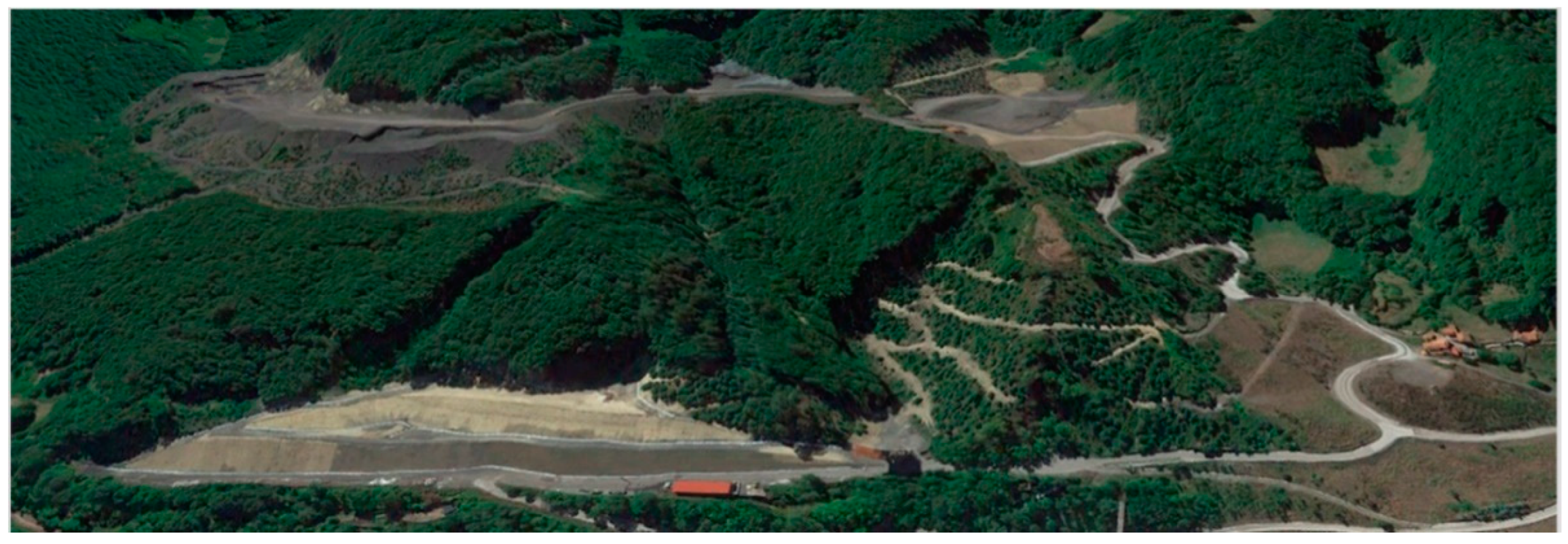
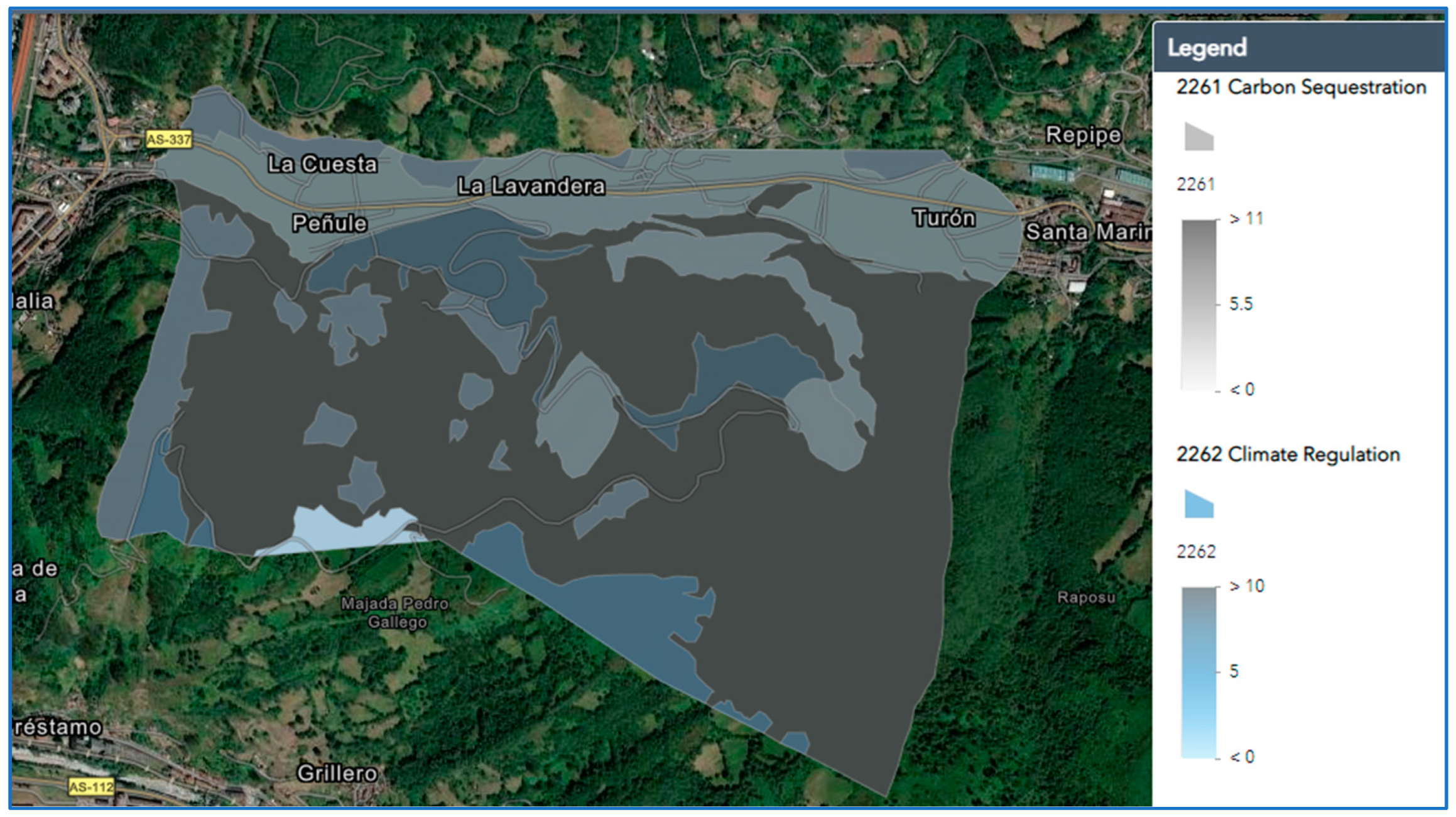
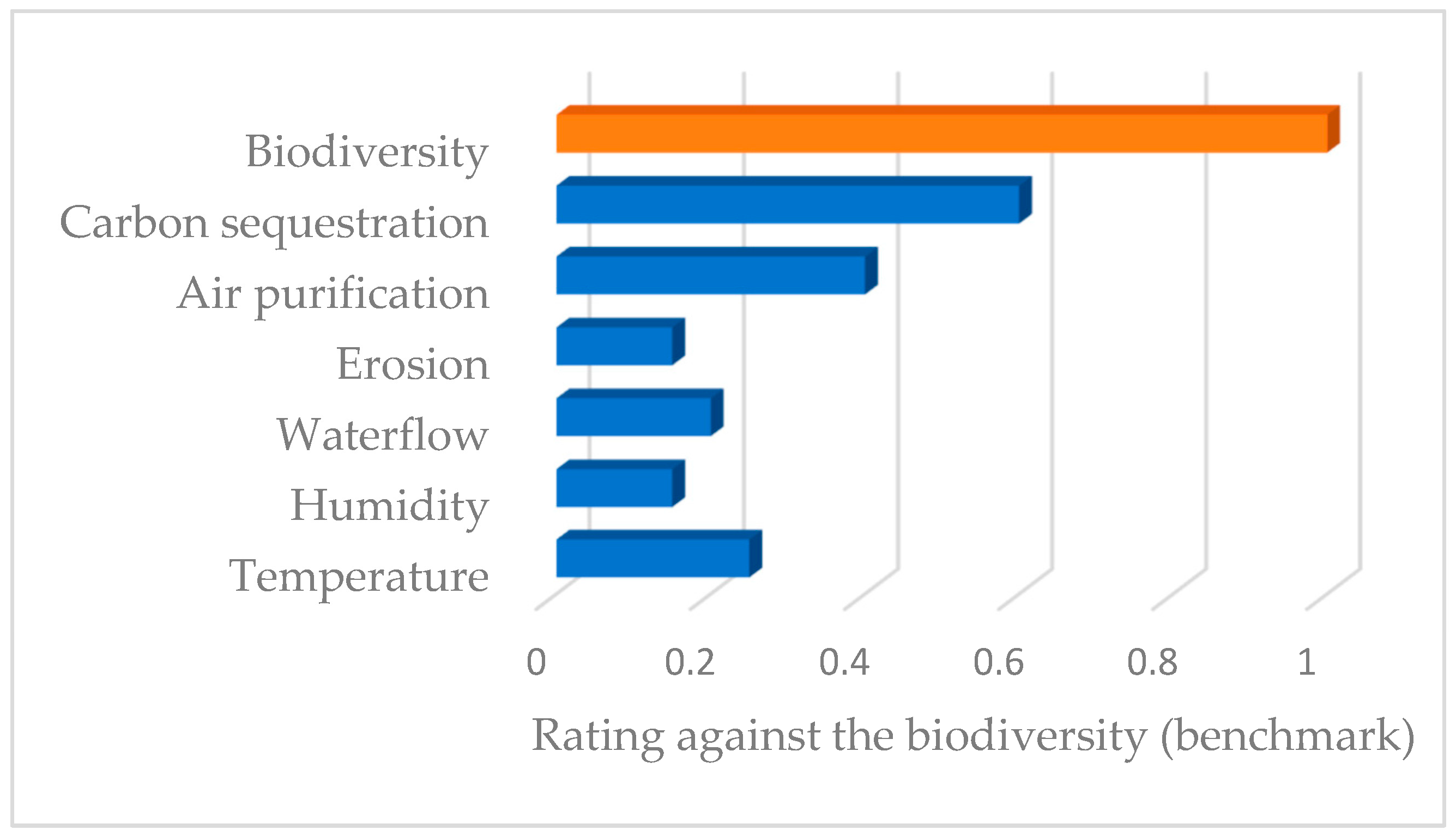
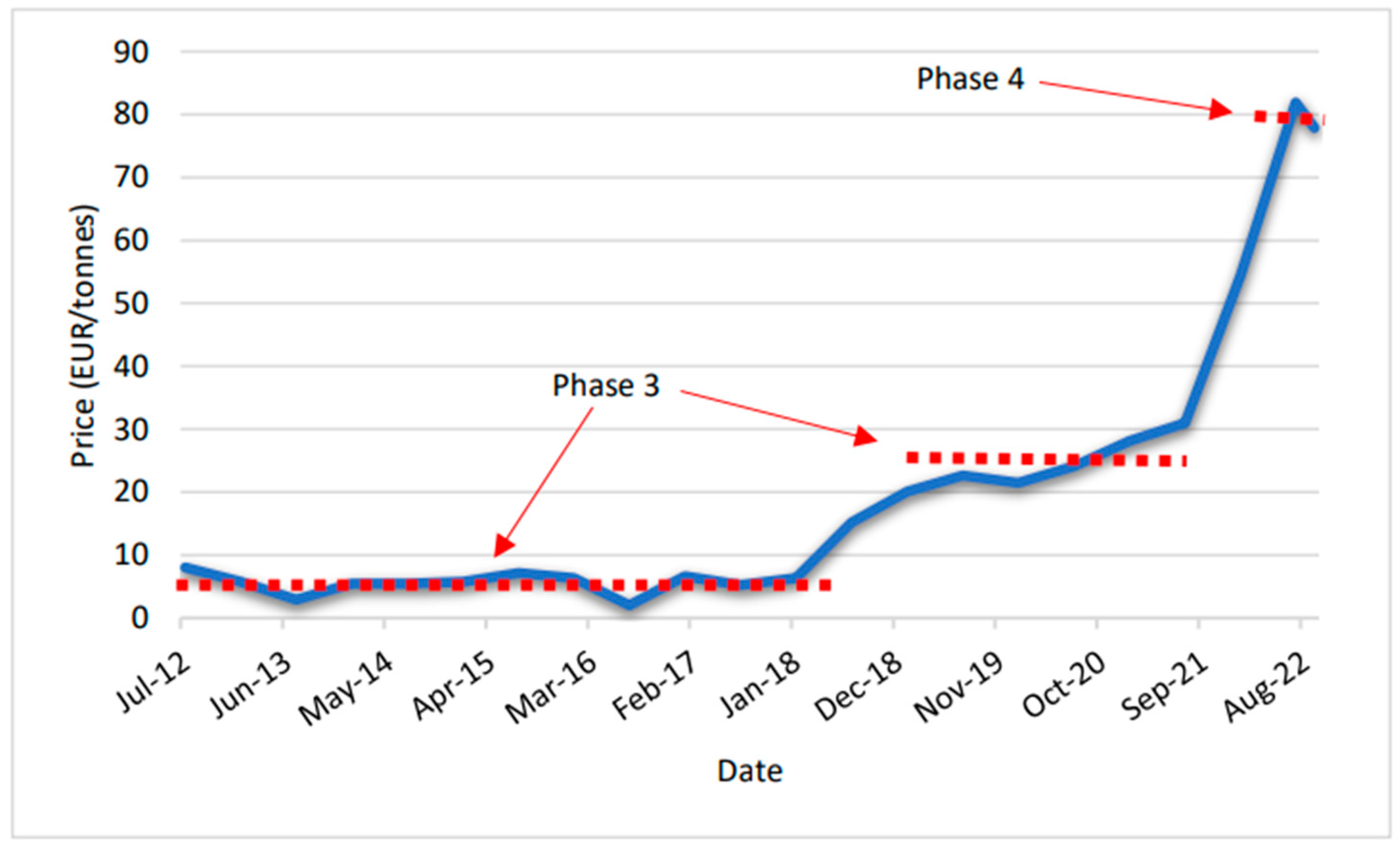
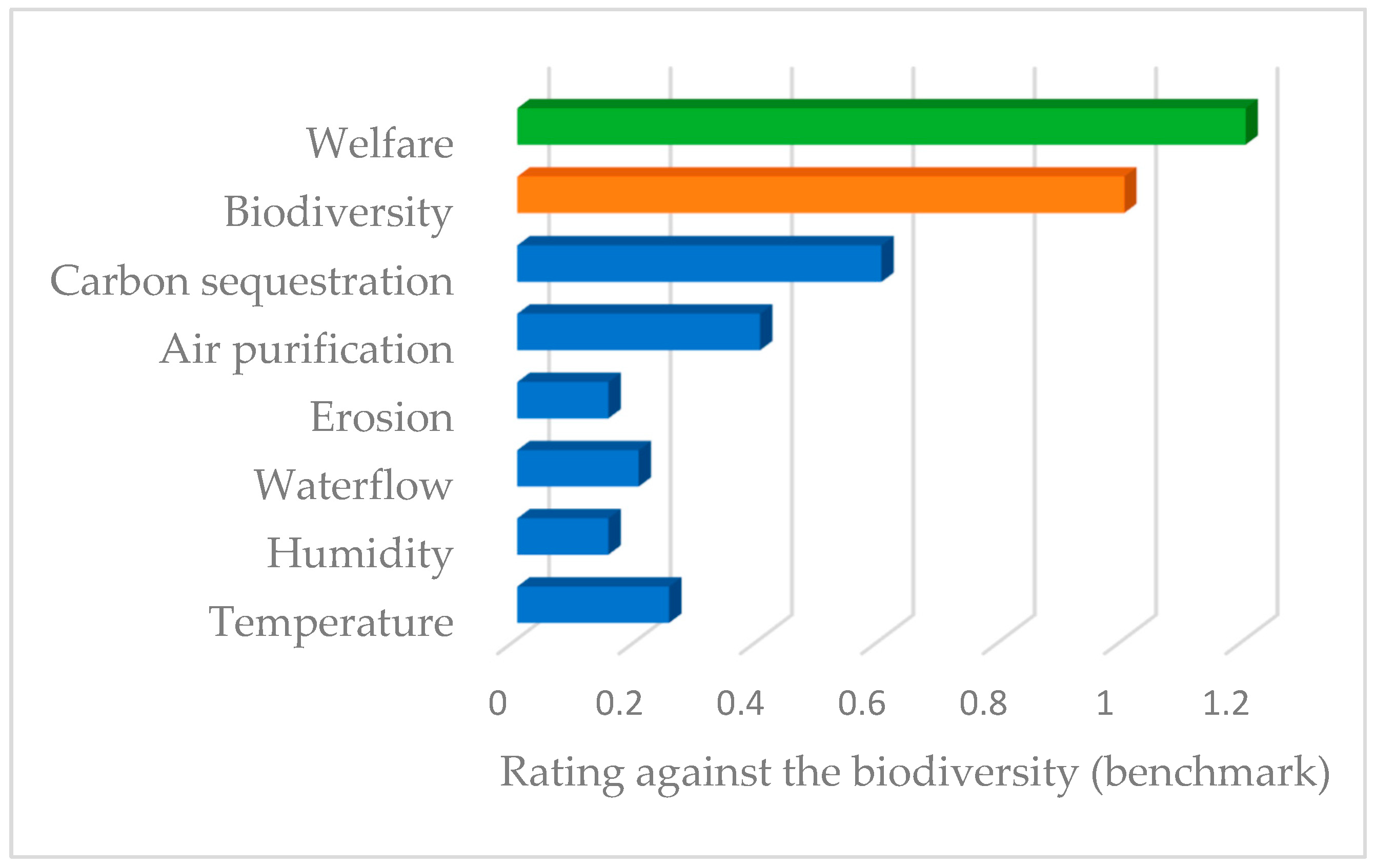
| Ecosystem service | Weight | Value |
|---|---|---|
| Temperature | 25% | EUR 1567 |
| Waterflow | 20% | EUR 1235 |
| Erosion | 15% | EUR 940 |
| Air purification | 40% | EUR 2507 |
| Carbon sequestration | 60% | EUR 3760 |
| Humidity | 15% | EUR 940 |
| Biodiversity | 100% | EUR 6267 |
| Total | EUR 17,216 |
| Scenarios | Provisioning Ecosystem Services NPV | Non-Provisioning Ecosystem Services Range | Non-Provisioning Ecosystem Services Value | Total Value |
|---|---|---|---|---|
| Landscape | EUR -5486 | 0.93 | EUR 16,011 | EUR 10,525 |
| Fibre | EUR 2386 | 0.60 | EUR 10,330 | EUR 12,716 |
| Food | EUR 3323 | 0.57 | EUR 9813 | EUR 13,136 |
| Ecosystem Service | Weight | Value |
|---|---|---|
| Temperature | 25% | EUR 5014 |
| Waterflow | 20% | EUR 4011 |
| Erosion | 15% | EUR 3008 |
| Air purification | 40% | EUR 8022 |
| Carbon sequestration | 60% | EUR 12,034 |
| Humidity | 15% | EUR 3008 |
| Biodiversity | 100% | EUR 20,056 |
| Total | EUR 55,154 |
| Scenarios | Provisioning Ecosystem Services NPV | Non-Provisioning Ecosystem Services Range | Non-Provisioning Ecosystem Services Value | Total Value |
|---|---|---|---|---|
| Landscape | EUR 5486 | 0.93 | EUR 51,293 | EUR 45,807 |
| Fibre | EUR 2386 | 0.60 | EUR 33,092 | EUR 35,478 |
| Food | EUR 3323 | 0.57 | EUR 31,438 | EUR 34,761 |
| Ecosystem Service | Weight | Value |
|---|---|---|
| Temperature | 25% | EUR 5014 |
| Waterflow | 20% | EUR 4011 |
| Erosion | 15% | EUR 3008 |
| Air purification | 40% | EUR 8022 |
| Carbon sequestration | 60% | EUR 12,034 |
| Humidity | 15% | EUR 3008 |
| Biodiversity | 100% | EUR 20,056 |
| Welfare | 120% | EUR 24,067 |
| Total | EUR 79,221 |
| Scenarios | Provisioning Ecosystem Services NPV | Non-Provisioning Ecosystem Services Range | Non-Provisioning Ecosystem Services Value | Total Value |
|---|---|---|---|---|
| Landscape | EUR -5486 | 0.65 | EUR 51,293 | EUR 45,807 |
| Fibre | EUR 2386 | 0.66 | EUR 52,346 | EUR 54,732 |
| Food | EUR 3323 | 0.70 | EUR 55,504 | EUR 58,829 |
Publisher’s Note: MDPI stays neutral with regard to jurisdictional claims in published maps and institutional affiliations. |
© 2022 by the authors. Licensee MDPI, Basel, Switzerland. This article is an open access article distributed under the terms and conditions of the Creative Commons Attribution (CC BY) license (https://creativecommons.org/licenses/by/4.0/).
Share and Cite
Krzemień, A.; Álvarez Fernández, J.J.; Riesgo Fernández, P.; Fidalgo Valverde, G.; Garcia-Cortes, S. Restoring Coal Mining-Affected Areas: The Missing Ecosystem Services. Int. J. Environ. Res. Public Health 2022, 19, 14200. https://doi.org/10.3390/ijerph192114200
Krzemień A, Álvarez Fernández JJ, Riesgo Fernández P, Fidalgo Valverde G, Garcia-Cortes S. Restoring Coal Mining-Affected Areas: The Missing Ecosystem Services. International Journal of Environmental Research and Public Health. 2022; 19(21):14200. https://doi.org/10.3390/ijerph192114200
Chicago/Turabian StyleKrzemień, Alicja, Juan José Álvarez Fernández, Pedro Riesgo Fernández, Gregorio Fidalgo Valverde, and Silverio Garcia-Cortes. 2022. "Restoring Coal Mining-Affected Areas: The Missing Ecosystem Services" International Journal of Environmental Research and Public Health 19, no. 21: 14200. https://doi.org/10.3390/ijerph192114200
APA StyleKrzemień, A., Álvarez Fernández, J. J., Riesgo Fernández, P., Fidalgo Valverde, G., & Garcia-Cortes, S. (2022). Restoring Coal Mining-Affected Areas: The Missing Ecosystem Services. International Journal of Environmental Research and Public Health, 19(21), 14200. https://doi.org/10.3390/ijerph192114200






